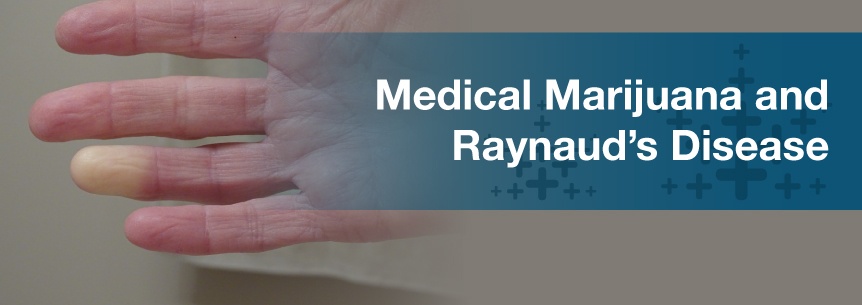
Struggling with Raynaud’s disease is no picnic. Symptoms can range from pain and swelling to throbbing and numb fingers and toes. Patients can become anxious and depressed having to cope with these and other unpleasant symptoms. Luckily, cannabis for Raynaud’s disease is available and can help ease some of these symptoms.
Medical cannabis is continuing to prove its effectiveness in decreasing and tackling symptoms linked with various conditions, now including Raynaud’s disease as well. Research shows medical marijuana and Raynaud’s disease treatment helps dilate blood vessels and maintains good blood flow to the hands.
Find A Doctor Find A Dispensary
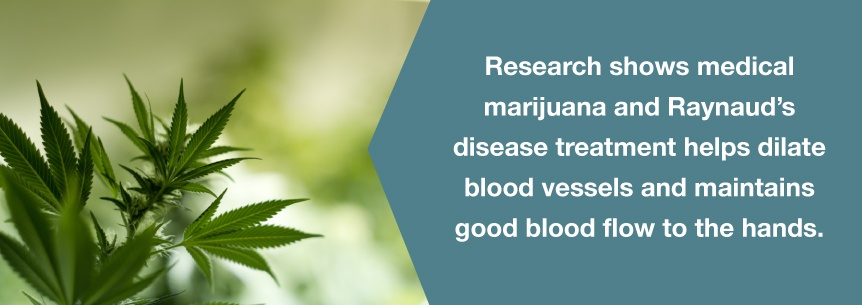
The primary cannabinoids in the cannabis plant, THC and CBD, have been shown to relieve stress, a huge trigger for constricting the flow of blood. Additionally, one of medical weed’s huge healing properties is relieving pain. With this, medical marijuana for Raynaud’s disease can help maintain consistent blood flow in the hands.
Medical pot is continuing to amaze both patients and doctors with its health benefits for the various disorders that affect people. Because Raynaud’s disease can be so distressing and uncomfortable, the good news is there is now hope through medical cannabis for Raynaud’s disease to eliminate some of the major triggers of the symptoms.
Individuals can benefit from using high-CBD oil. Mix it up with a topical oil like THC/coconut oil, and the effects may amaze you.
Some symptoms marijuana for Raynaud’s disease can help with include:
Below are some effective cannabis strains to help relieve your symptoms of Raynaud’s disease, such as:
You may also benefit from the Sweet Releaf strain. You apply it once or twice a day to the affected area. Patients report a warming feeling after about 15 minutes and reduction of pain which can last for hours or longer.
You can use medical weed in various ways other than just smoking it in a joint. For instance, you can use:
The form of cannabis ingestion is an essential consideration, as research shows smoking the herb can affect blood flow. Safer methods of ingestion include creams and topicals, which you can apply to your feet and hands that are affected by Raynaud’s.
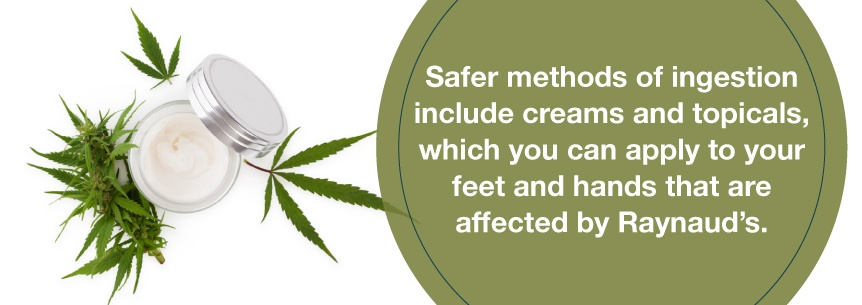
You can also eat CannaButter in edibles like cakes and cookies. You can apply medical marijuana as a tincture of cannabis oil, where you place a few drops under your tongue or add some to your bath.
For more information on cannabis for Raynaud’s disease, check out our resources section here at MarijuanaDoctors.com. Then book your appointment with one of our friendly, qualified marijuana doctors for a consultation to begin your medical cannabis treatment. They’ll answer any questions you have, give you advice, provide you with a recommendation and point you in the right direction to any information you seek.
Find A Doctor Find A Dispensary
Raynaud’s (pronounced ray-NODES) disease is a rare condition affecting the blood vessels, typically in your toes and fingers. It causes your blood vessels to narrow when you’re feeling stressed or are cold. When this occurs, blood can’t get to your skin surface and the areas affect turn blue and white. When the flow of your blood returns, your skin tingles or throbs and turns red. In severe cases, blood flow loss can cause tissue death or sores.
Individuals who live in colder climates have a higher chance of developing Raynaud’s. It’s also more common in females, those over 30 years old and those with a family history.
Treatment for this condition might include medications to keep the blood vessels open. You can also take some steps to try and avoid it such as:
There are two primary types of Raynaud’s disease. Primary Raynaud’s occurs on its own. There’s no known cause. There’s also secondary Raynaud’s, which often occurs due to other diseases, injuries or certain medications.
As the most common type of Raynaud’s disease, this doesn’t result from an associated medical condition. Many individuals with the primary type don’t seek treatment because it can be extremely mild and will sometimes resolve on its own.
Also called Raynaud’s phenomenon, an underlying problem can cause this type. While the secondary type form isn’t as common as the primary type, it can be more severe. Symptoms and signs of the secondary type typically show up in individuals around the age of 40.
Primary Raynaud’s disease risk factors include:
Secondary Raynaud’s risk factors include:
This condition can affect some individuals who expose themselves to the cold. Your blood vessels contract in your toes and fingers when temperatures drop. These contractions cause a lack of oxygen, or hypoxia, to affected tissues. Toes and fingers can feel number and cold to the touch.
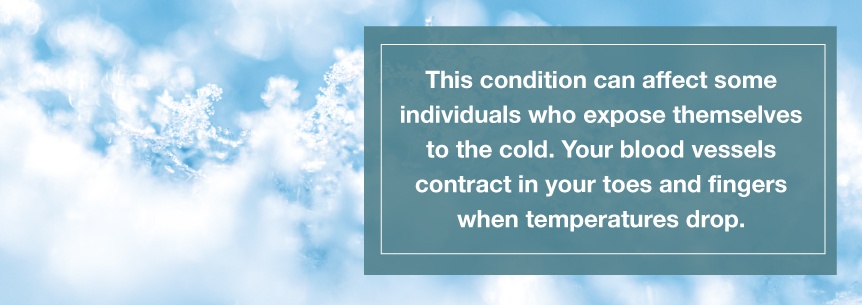
Frequently, the affected area will turn white and then afterward turn blue. Once you warm the area and the flow of blood returns, you may experience tingling sensations that accompany a red flush and potential swelling. You may also experience a throbbing, painful feeling.
Fingers and toes are typically affected, but the disease can also affect your lips, nose and ears.
Some women might experience Raynaud’s phenomenon of their nipples, particularly while breastfeeding. It causes serious throbbing, much like the sensation with a fungal Candida albicans infection, and this can result in a misdiagnosis.
An episode can last about 15 minutes, which includes the time it takes your body to become normal again.
Doctors don’t fully know the exact cause of Raynaud’s attacks. However, they do believe blood vessels in your feet and hands seem to overreact to stress or cold temperatures.
With this condition, arteries to your toes and fingers go into vasospasm when exposed to stress or cold, making your vessels narrow and limiting your blood supply temporarily. As time goes on, the small arteries become slightly thicker and further limit the flow of blood.
Cold temperatures are the most common reason for an attack. Common ways you expose your hands to cold include:
For some individuals, a Raynaud’s attack can come on because of emotional stress. When air conditioning triggers an episode, you could be experiencing a Raynaud’s spasm.
Secondary Raynaud’s can result from the following:
These include Buerger’s disease or a disorder where the blood vessels in the feet and hands become inflamed, as well as atherosclerosis — a buildup of plaque in the blood vessels that feed the heart — and primary pulmonary hypertension — a type of high blood pressure affecting the lungs’ arteries.
Most individuals who have scleroderma, a rare disease leading to scarring and hardening of the skin, also have Raynaud’s disease. Other disorders that increase your risk of Raynaud’s are:
Smoking makes the blood vessels constrict.
Repetitive movements like playing the piano, typing and performing similar movements for a long period, as well as vibrating tools like jackhammers, can result in overuse injuries.
These include:
These include surgery, wrist fracture or frostbite.
Raynaud’s disease is typically not life-threatening, but there can be complications.
Chilblains can occur when there’s an issue with blood circulation and Raynaud’s is one potential cause. With chilblains, the skin becomes red, itchy and swollen and can feel tender, hot and like they are burning. Chilblains typically resolve themselves in one to two weeks, but can return. You can prevent these by keeping your extremities warm. If your feet and hands become cold, slowly warm them up, since too much heat can cause more damage.
If your symptoms become worse and you have a significantly reduced blood supply for a long time, your toes and fingers can become deformed.
If oxygen can’t get to the area, gangrenous tissue and skin ulcers can develop. Both these two complications can be hard to treat. They might even require amputation eventually.
In a study of 313 participants with primary Raynaud’s, researchers measured outcomes for severity, pain and attack rate. The researchers expected anxiety and stress would be associated with characteristics of a Raynaud’s phenomenon attack when mild outside temperatures created partial or no digital vasoconstriction.
Researchers speculated that in warm temperature categories, as opposed to temperatures below 40 degrees Fahrenheit, higher anxiety or stress would be linked with more severe, frequent and painful attacks.
Predictors were:
Researchers tested anxiety and stress in separate models. Higher anxiety associated with more frequent above 60 degrees Fahrenheit attacks. Stress wasn’t a significant predictor of Raynaud’s disease attack characteristics.
Raynaud’s disease is chronic. Like with all chronic conditions, particularly those that cause pain, it can put people into depressed moods. Feelings of hopelessness set in when you’re continually struggling with the symptoms of a chronic condition.
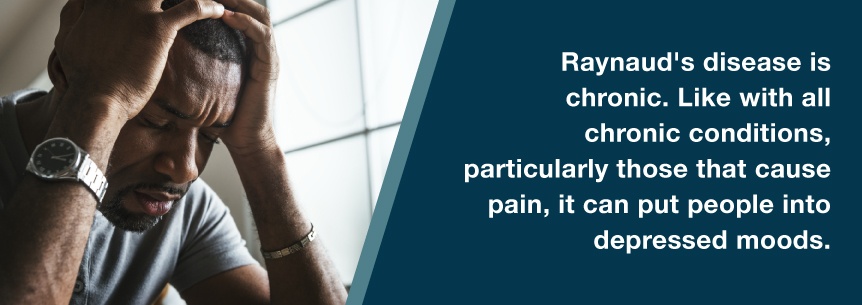
Raynaud’s, whether in the disease or phenomenon type, is named after the French physician Maurice Raynaud, who first identified the condition in 1862. Although more than 150 years have passed since Raynaud first recognized the condition, researchers and medical professionals aren’t entirely clear on its cure, cause and treatment aren’t clear.
The National Institute of Arthritis and Musculoskeletal and Skin Diseases estimates show:
The Raynaud’s Association reports an estimated 28 million people in the U.S. have Raynaud’s. However, only one in 10 individuals suffering from the condition seeks treatment.
The goal of treatment is to:
Primary treatments for Raynaud’s include avoiding triggers like cold air and water, as well as medications and surgery in severe cases.
Depending on the underlying cause of your symptoms, medicine could help. To widen blood vessels and encourage circulation, the doctor may prescribe you:
These medications help relax and open tiny blood vessels in your feet and hands, reducing the severity and frequency of attacks. They may also help heal skin ulcers on your toes and fingers. Some examples of calcium channel blockers are amlodipine (Norvasc) and nifedipine (Procardia, Afeditab CR).
Potential side effects of calcium channel blockers include:
These medications help relax blood vessels and include nitroglycerin cream you apply to the base of your fingers for healing skin ulcers. Other examples of vasodilators are:
For severe cases of Raynaud’s, surgery and procedures could be a treatment option. Some include:
Calcium channel blockers are typically the first line of defense, but in some individuals aren’t effective. Those with intolerance to available treatments or severe symptoms have encouraged exploration of alternative therapies, including:
Also, researchers have completed or in the process of studying the results of more than 60 clinical trials for Raynaud’s disease and Raynaud’s phenomenon. They are studying the effects of various drugs, devices and medical procedures on the condition.